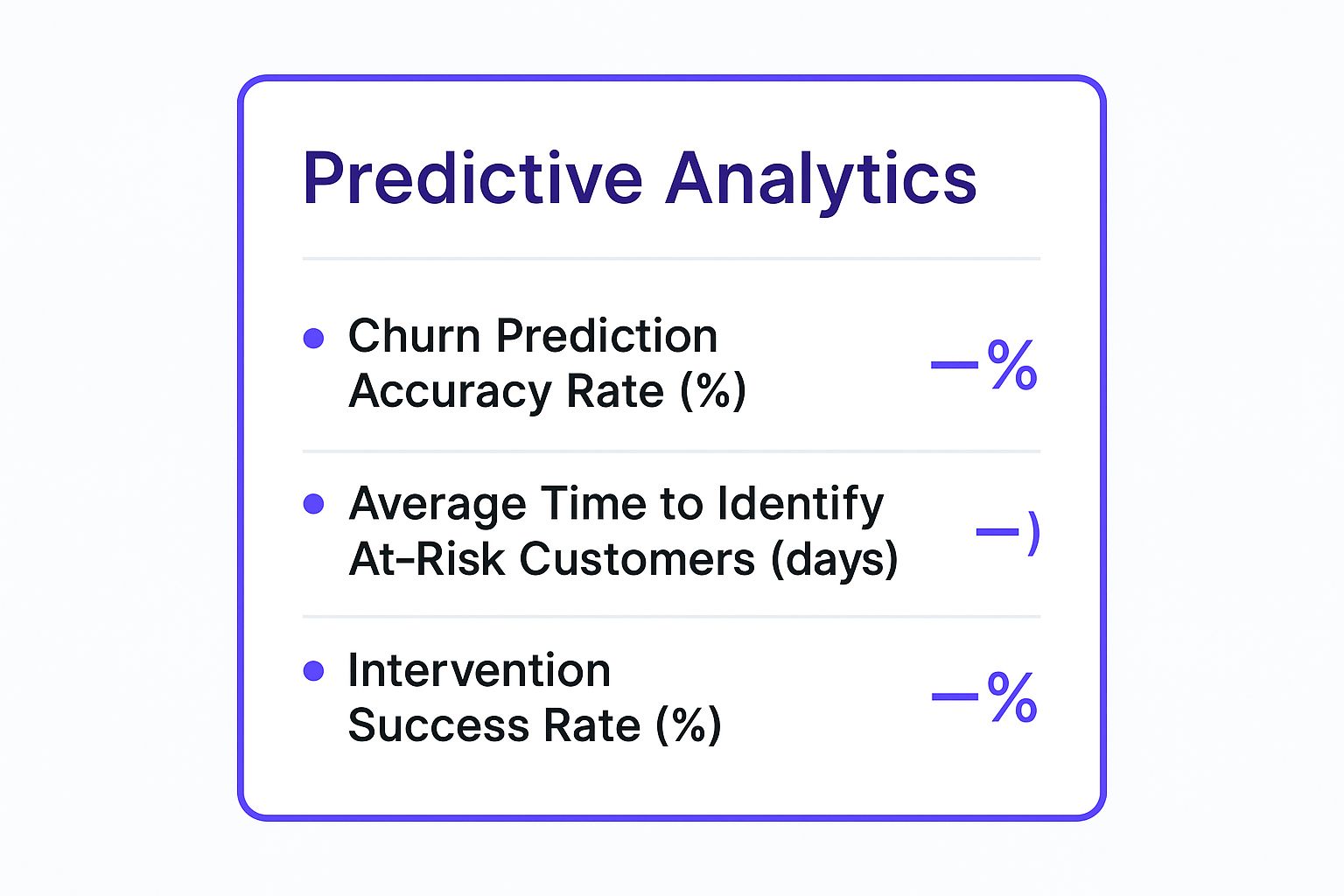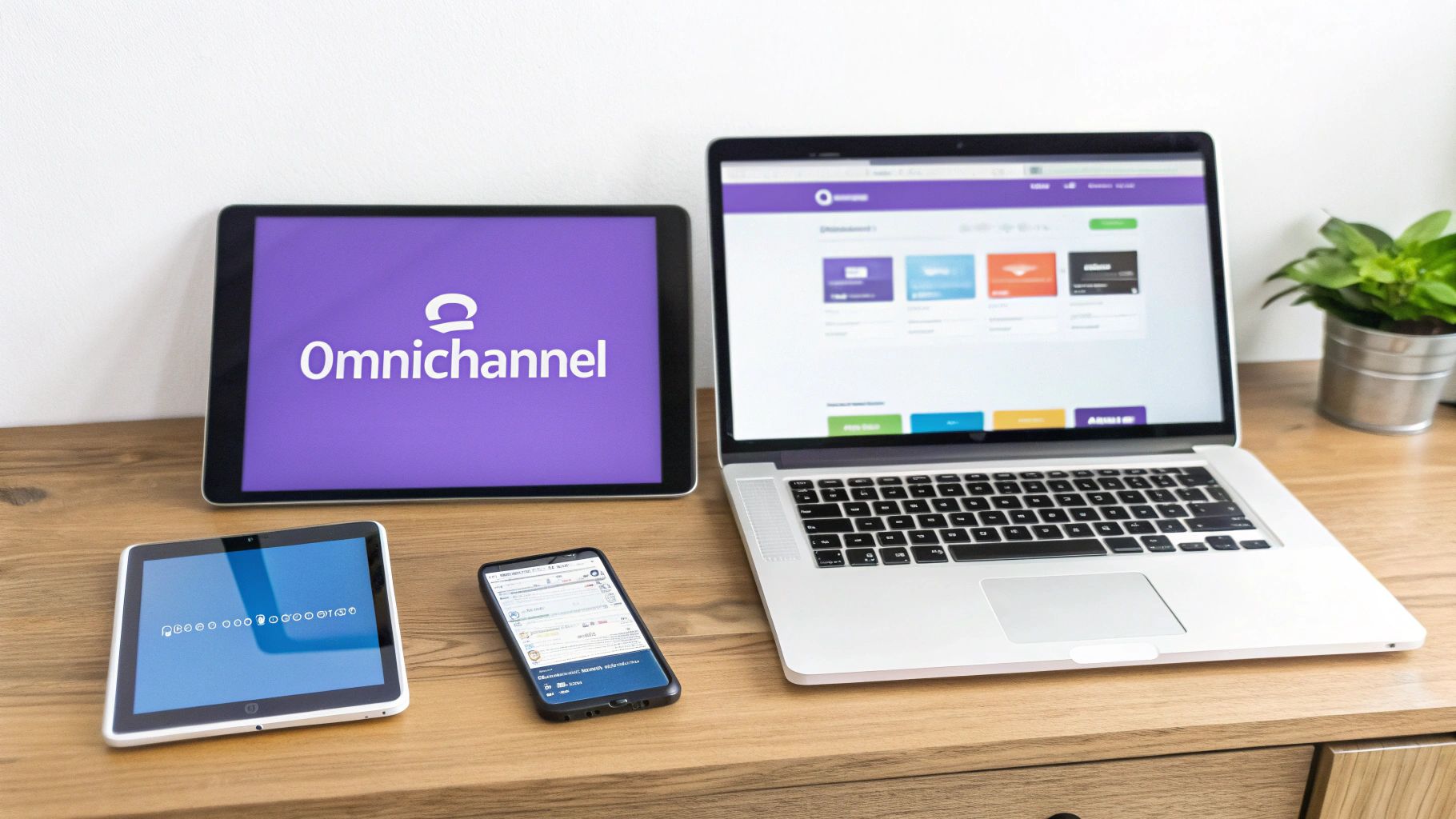
Customer churn remains a critical challenge for businesses, directly impacting revenue and long-term growth. The standard playbook for customer retention is no longer sufficient. The advent of sophisticated AI and machine learning has created a new frontier for Customer Success Managers (CSMs) and executives, offering unprecedented tools to not just manage, but proactively reduce churn rate.
Moving beyond generic advice, this guide delves into eight powerful, AI-enabled strategies designed to transform your approach. We will explore how platforms like Statisfy are leveraging Generative AI to turn complex customer data into actionable, churn-reducing insights. For leaders aiming to implement these systems, understanding the foundational concepts is key; practical insights into unlocking your AI agent for business success can provide a critical roadmap for turning theoretical potential into tangible results.
Prepare to go beyond reactive measures and discover how to build a resilient, proactive, and data-driven retention engine. This article provides the blueprint for implementing advanced strategies, from predictive analytics and personalized onboarding to automated win-back campaigns. You will gain actionable steps to secure your customer base and drive sustainable growth for the future.
The most effective way to reduce churn rate is to stop it before it starts. Predictive analytics offers a data-driven approach, using machine learning to identify customers at risk of leaving long before they make a final decision. This strategy moves your team from a reactive "firefighting" mode to a proactive, preventative stance. By analyzing vast datasets of customer behavior, usage patterns, and engagement metrics, these models can calculate a churn probability score for each individual user.
For example, a B2B SaaS company might find that a sudden drop in feature usage, a decrease in login frequency, and a lack of support ticket submissions are strong indicators of a future cancellation. Similarly, an e-commerce brand can analyze purchase frequency, average order value, and browsing history to spot customers who are losing interest.
To leverage this powerful strategy, organizations must first ensure they have clean, comprehensive customer data. The quality of your predictions is directly tied to the quality of your data input.
Leveraging advanced AI can provide invaluable insights into customer behavior. For instance, one report details how AI-powered churn prediction capabilities identified at-risk accounts 47 days before cancellation, giving teams ample time to intervene effectively.
The following infographic highlights the key performance indicators that successful predictive analytics systems track.

Tracking these metrics ensures your predictive models are not only accurate but also provide a tangible, positive impact on your efforts to reduce churn rate.
A customer's first impression is often their most lasting one, and a generic, one-size-fits-all onboarding experience is a leading cause of early-stage churn. Personalized customer onboarding addresses this directly by creating a tailored initial journey based on a user's specific goals, role, or industry. This strategic approach ensures new customers achieve their first "win" quickly, demonstrating value and cementing their decision to choose your product, which is a critical step to reduce churn rate.

For instance, Slack provides distinct onboarding flows for different team types, such as engineering versus marketing, highlighting relevant channels and integrations. Similarly, Canva assesses a user's design skill level during signup and customizes the initial tutorials and template suggestions accordingly. This level of personalization makes the product feel immediately relevant and less overwhelming, dramatically improving a user's path to activation.
To successfully implement this strategy, you must move beyond a single, linear welcome tour and think in terms of dynamic user pathways. The goal is to guide each user segment to their specific "aha!" moment as efficiently as possible.
This approach, popularized by product-led growth advocates and customer success platforms like Gainsight, transforms onboarding from a simple tutorial into a powerful retention tool. By investing in a tailored first experience, you build a strong foundation for a long-term, successful customer relationship, making it a highly effective method to reduce churn rate from day one.
Moving beyond reactive support, proactive Customer Success Management (CSM) is a strategic function dedicated to ensuring customers achieve their desired outcomes while using your product. It’s about building long-term, value-driven relationships, not just solving problems as they arise. This approach shifts the focus from product features to business outcomes, making your service indispensable to the customer's own success and fundamentally helping to reduce churn rate.
For example, Salesforce assigns dedicated CSMs who guide enterprise clients through complex implementations and ongoing optimization, ensuring they maximize their ROI. Similarly, HubSpot’s customer success team doesn't just teach users how to use the software; they help them achieve specific marketing and sales goals, directly tying platform usage to tangible business growth. This proactive partnership transforms the customer relationship from transactional to strategic.
To effectively deploy proactive CSM, you must build a structured, goal-oriented program that anticipates customer needs and guides them toward success. This requires a deep understanding of your customer's business.
The core principle, as popularized by thought leaders like Lincoln Murphy and Gainsight’s Nick Mehta, is that customer success is a company-wide philosophy. For instance, Gainsight itself offers a comprehensive platform designed to help businesses operationalize this very strategy, providing the tools needed to monitor health, manage tasks, and engage customers at scale.
Focusing on proactive engagement ensures customers continuously see and feel the value of their investment, making them far less likely to churn when renewal time arrives.
A primary driver of churn is a mismatch between perceived value and cost. Value-based pricing and packaging directly addresses this by aligning the price customers pay with the tangible benefits they receive. Instead of a one-size-fits-all approach, this strategy offers flexible tiers and consumption models, ensuring customers feel their investment is fair and justified, which is a powerful way to reduce churn rate.
For example, a company like Snowflake utilizes a consumption-based model where clients pay only for the compute and storage resources they actually use. This eliminates the risk of a customer paying for shelfware. Similarly, Slack’s per-active-user pricing ensures that businesses aren't charged for inactive accounts, directly tying cost to active team collaboration and value. This alignment makes the service feel indispensable rather than an expensive overhead.
Shifting to a value-based model requires deep customer understanding and a commitment to flexibility. The goal is to create a pricing structure that grows with your customers, reinforcing your role as a partner in their success.
Pioneered by experts like Hermann Simon and championed by firms like ProfitWell, value-based pricing is more than a monetization tactic; it's a core retention strategy. By ensuring customers pay for the value they get, you embed your product into their operational success, making it far more difficult to replace.
Customer churn is often the result of friction and disjointed interactions. An omnichannel customer experience strategy directly addresses this by creating a seamless and consistent journey across all touchpoints, whether it's your website, mobile app, social media, or in-person support. This approach ensures customers don't have to repeat themselves or navigate confusingly different processes, which is a key driver in the decision to stay or leave. By unifying these channels, you significantly reduce the frustration that can lead to churn.
For instance, a customer might start a support chat on your mobile app, then call a support agent later. In an omnichannel model, that agent has the full context of the previous chat, allowing them to pick up the conversation without missing a beat. Major brands like Starbucks exemplify this by integrating their mobile app, loyalty program, and in-store experience into one cohesive ecosystem, making it effortless for customers to engage and transact. This unified approach is a powerful tool to reduce churn rate by fostering convenience and loyalty.
To build a truly integrated customer experience, you must first understand the customer's journey from their perspective and then unify the underlying technology and processes. The goal is to make channel-switching invisible to the user.
The core principle of this strategy is to meet customers where they are and provide a consistently positive experience. Leaders in customer experience, such as those at Forrester Research, have long advocated for this holistic view, demonstrating its direct impact on customer loyalty and retention. By breaking down internal silos and focusing on a unified journey, businesses can create an environment where customers feel understood and valued, making them far less likely to churn.
Implementing a structured loyalty and rewards program is a powerful strategy to reduce churn rate by giving customers compelling financial and emotional reasons to stay. This approach moves beyond transactional relationships to build a community of brand advocates. By incentivizing continued engagement and purchases through exclusive benefits, points systems, and recognition, you create significant switching costs and foster a deeper connection that competitors find difficult to break.
For example, Sephora’s Beauty Insider program excels by offering tiered benefits, exclusive access to new products, and personalized rewards, making customers feel valued and understood. Similarly, Amazon Prime creates immense loyalty by bundling a wide array of benefits like fast shipping, streaming services, and exclusive deals, making the subscription indispensable for its members. These programs effectively transform customer satisfaction into long-term loyalty.

A successful program requires more than just offering discounts; it must be deeply integrated into the customer experience and deliver genuine, perceived value. The goal is to make customers feel recognized and rewarded for their commitment.
Leveraging platforms like Yotpo or Smile.io can accelerate implementation, providing the tools needed to build, manage, and analyze a sophisticated rewards system. Ultimately, a well-executed loyalty program is a proactive measure that builds a defensive moat around your customer base, making your business more resilient to churn.
A stagnant product is a magnet for churn. Continuous product innovation is a strategic approach to consistently enhance and expand your product's capabilities, ensuring it not only keeps pace with but also anticipates evolving customer needs. This strategy directly helps to reduce churn rate by making the product indispensable. By delivering a steady stream of valuable updates, you reinforce the product's value, maintain a competitive edge, and keep users engaged and excited about their investment.
This proactive development cycle shows customers that you are actively listening and committed to their long-term success. For instance, Slack transformed from a simple messaging app into a business communication hub by continuously adding workflow automation and deep integration features. Similarly, Notion evolved from a basic note-taking tool to an all-in-one workspace by rapidly expanding its feature set based on user demand, creating a stickier, more versatile platform.
To make innovation a core part of your retention efforts, you need a structured process that turns customer needs into tangible product enhancements. The goal is to create a predictable rhythm of improvement that customers can rely on.
Product management thought leaders like Marty Cagan emphasize that the most successful products are those that continuously solve customer problems in ways customers love. By systematically improving your product, you make it harder for competitors to lure your customers away and demonstrate a commitment that is fundamental to reducing churn.
Losing a customer doesn't have to be the end of the relationship. A proactive win-back strategy uses automated, personalized communication sequences to re-engage customers who have already churned or are showing strong signs of disengagement. This approach combines behavioral triggers with compelling offers and strategic timing to systematically and scalably win back these valuable accounts, directly helping to reduce churn rate over the long term.
For example, a subscription service like Spotify might send a former user an email highlighting a personalized playlist of new music they would love, paired with a special "come back" discount on a premium plan. Similarly, a B2B SaaS tool like Dropbox could target inactive users with automated campaigns showcasing powerful new features they haven't tried yet, demonstrating renewed value and encouraging them to log back in.
To execute this strategy effectively, you need a combination of customer data, automation technology, and compelling messaging. The goal is to make the customer feel valued and understood, not just spammed with generic promotions.
As noted by retention experts at platforms like HubSpot, a key to success is understanding why customers left in the first place. Sending a pre-campaign survey can provide invaluable insights to craft more relevant and persuasive win-back messages. This data-driven approach turns a simple outreach into a highly targeted and effective retention tool.
The journey to effectively reduce churn rate is not about finding a single silver bullet. Instead, it’s about architecting a sophisticated, interconnected system where each component amplifies the others. The eight strategies we've explored, from predictive analytics to automated win-back campaigns, are not standalone tactics; they are the essential gears in a powerful customer retention flywheel. By integrating them, you transform your approach from a reactive, defensive posture into a proactive, growth-oriented engine.
The core principle is synergy. Your predictive analytics and early warning systems are the eyes and ears of your operation, identifying subtle shifts in customer behavior. These critical insights don't just sit in a dashboard; they directly fuel personalized onboarding flows, ensuring new users achieve their "aha!" moment faster. This data then empowers your Customer Success Managers to shift from fighting fires to proactively delivering value, guided by AI-driven recommendations.
Mastering this integrated approach is what separates companies with acceptable churn from those with exceptional retention. Think of how these elements work together:
Building this flywheel requires a commitment to a holistic, data-first culture. It's about breaking down silos between marketing, sales, product, and success teams. When every department has access to a unified view of the customer journey, powered by intelligent automation, your ability to reduce churn rate becomes a fundamental, sustainable competitive advantage. This isn't just about saving customers; it's about building a business that customers don't want to leave.
The true value lies in creating a virtuous cycle. As you reduce churn, you increase customer lifetime value, generate more predictable revenue, and gather richer data from your loyal user base. This improved data then feeds back into your predictive models, making them even more accurate and your entire retention engine more efficient. This is how leading organizations turn customer retention into their most powerful driver of sustainable, long-term growth.
Ready to unify your data and build your own churn reduction flywheel? Statisfy provides the AI-powered customer success platform to connect your data, predict at-risk accounts, and automate the proactive workflows needed to reduce churn rate. Discover how our platform can become the central hub for your customer retention strategy by visiting Statisfy today.